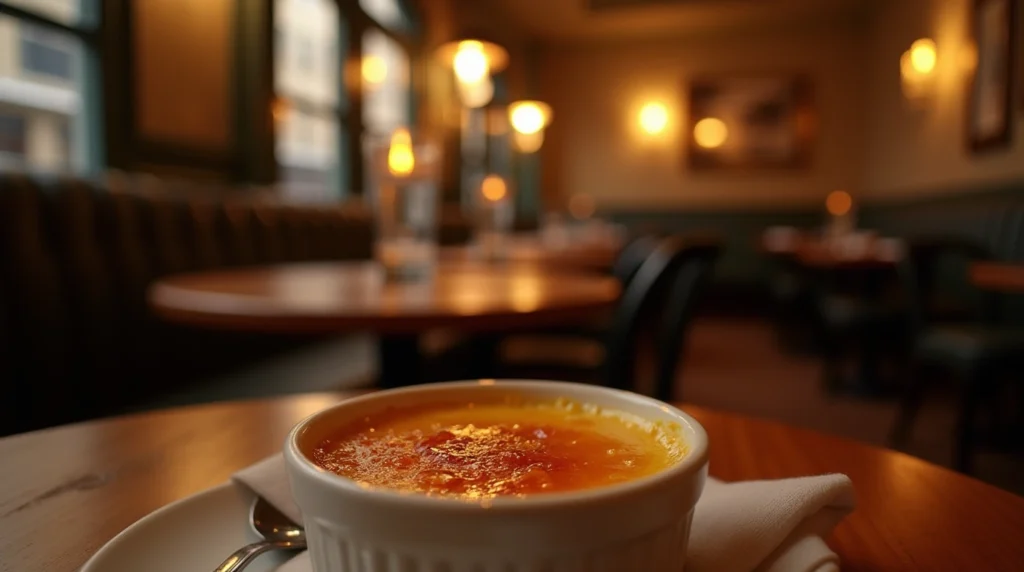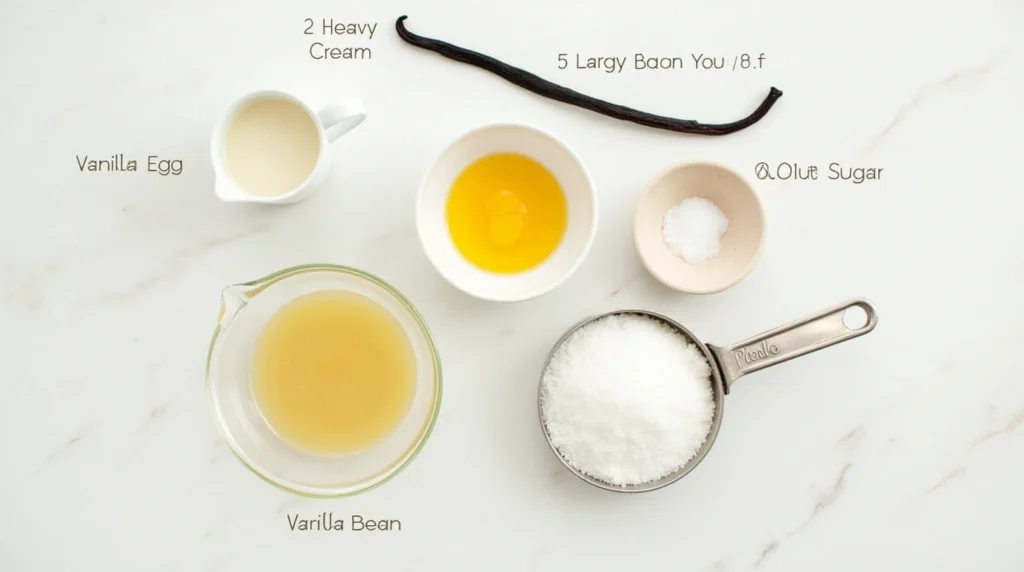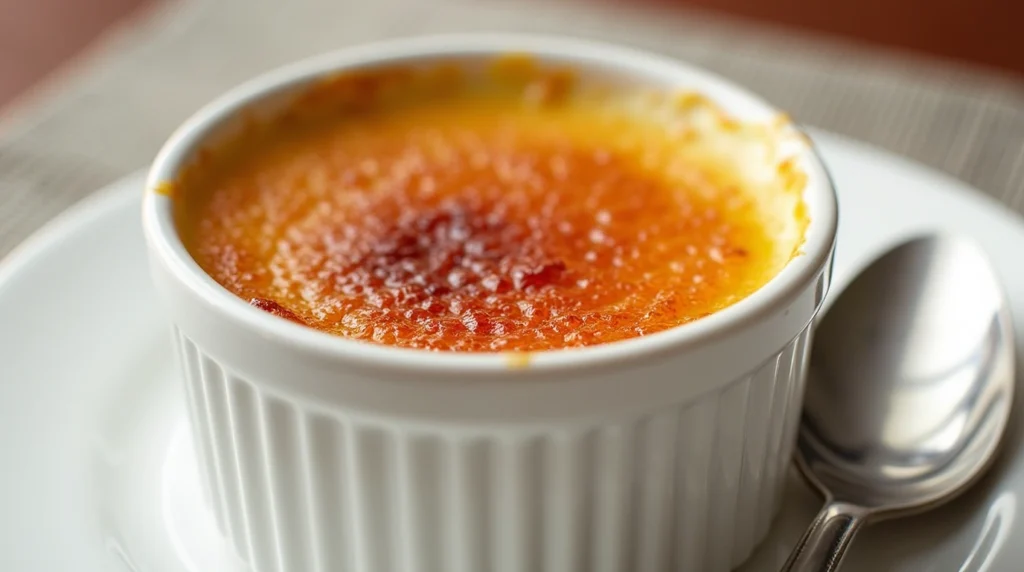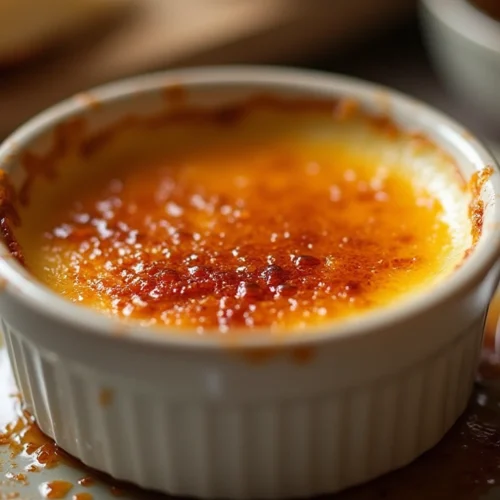custardy french dessert nyt : Crème brûlée is more than just a dessert—it’s an indulgence that brings together silky smooth custard and a satisfying crack of caramelized sugar. This French classic is a celebration of simplicity, elegance, and irresistible flavor.
Table of Contents
A Culinary Journey: My First Encounter with a Custardy French Dessert NYT-Inspired

I first encountered crème brûlée in a quaint Parisian bistro tucked away in the Marais district. As the waiter presented the delicate ramekin, the golden crust gleamed under the soft glow of candlelight. When I cracked the sugar top with my spoon, the sound was almost as satisfying as the taste itself. The smooth custard beneath was a revelation, leaving me in awe of how something so simple could be so luxurious. That moment sparked a deep love for the dessert, and it became a benchmark for my understanding of French pastry.
Unveiling the Essence: What Makes It ‘Custardy’?
At the heart of crème brûlée lies a flawless custard made with eggs, cream, and sugar. The eggs act as the binding agent, enriching the custard with their natural proteins, while the heavy cream gives it its signature silkiness. The sugar, usually caramelized on top, creates that beloved crunch. The key to the perfect custard lies in gentle cooking: heating the cream and eggs slowly while constantly stirring to prevent curdling. This slow process results in a smooth, velvety texture that feels like a luxurious cloud on the tongue.
A Deep Dive into History and Tradition
Crème brûlée’s origins are a bit murky, with several countries claiming its invention, but the most popular story is its French heritage. It is believed to have first appeared in the 17th century, in the kitchens of French aristocracy. The dessert was originally called “crème anglaise” in some regions, but it evolved into the modern crème brûlée when the top was caramelized with a hot iron. Over time, it became a favorite of French kings, cementing its place as an emblem of decadent French cuisine. Variations have sprouted over the years, but the core elements of the dish have remained remarkably unchanged.
Ingredients:

- 2 cups heavy cream
- 1 vanilla bean (or 1 tablespoon vanilla extract)
- 5 large egg yolks
- 1/2 cup granulated sugar (plus extra for caramelizing)
- Pinch of salt
Instructions:
- Preheat the oven to 325°F (160°C). Place 4 to 6 ramekins (depending on size) into a large baking dish or roasting pan.
- Infuse the cream: In a medium saucepan, heat the heavy cream and vanilla bean over medium heat. If using a vanilla bean, split it open, scrape out the seeds, and add both seeds and pod to the cream. Bring to a simmer, then remove from heat and let it steep for 10-15 minutes to allow the vanilla flavor to infuse. If using vanilla extract, add it later.
- Whisk the egg yolks: In a separate bowl, whisk together the egg yolks, granulated sugar, and a pinch of salt until smooth and pale.
- Temper the eggs: Slowly pour the hot cream into the egg mixture, whisking constantly to prevent curdling. Once combined, pour the mixture back into the saucepan and cook gently over low heat for 2-3 minutes, stirring constantly. If using vanilla extract, add it to the mixture now.
- Strain the custard: To ensure a silky smooth texture, strain the custard through a fine-mesh sieve into a clean bowl, discarding the vanilla pod (if used).
- Bake in a water bath: Pour the custard evenly into the ramekins. Carefully pour hot water into the baking dish until it reaches halfway up the sides of the ramekins. Bake for 40-45 minutes, or until the custard is set but still slightly wobbly in the center.
- Cool and chill: Remove the ramekins from the water bath and let them cool to room temperature. Once cooled, cover and refrigerate for at least 2 hours or up to 2 days.
- Caramelize the sugar: Just before serving, sprinkle a thin, even layer of granulated sugar on top of each custard. Using a kitchen torch, carefully caramelize the sugar until golden and crisp. If you don’t have a torch, you can also place the ramekins under a broiler for 1-2 minutes, but watch carefully to avoid burning.
- Serve and enjoy: Once the sugar has hardened, serve immediately and enjoy the perfect balance of creamy custard and crispy sugar.
Mastering the Art: Tips and Techniques for the Home Cook
When making crème brûlée at home, patience is key. The custard must be baked gently in a water bath (or bain-marie) to ensure even cooking without curdling. This process keeps the temperature steady, allowing the eggs to thicken without scrambling. I recommend using a kitchen torch to caramelize the sugar—it’s more reliable than the broiler and offers better control over the sugar’s caramelization. One common pitfall is overbaking the custard, which can result in a texture that’s more like scrambled eggs. Aim for a subtle jiggle in the center when it’s done—this means the custard has set perfectly.
Beyond the Classic: Variations and Modern Interpretations
Though the classic vanilla crème brûlée is an undeniable favorite, chefs have experimented with countless variations. Citrus zest, like orange or lemon, infuses the custard with a refreshing note, while spices like cinnamon or cardamom lend warmth. For those seeking to add a modern twist, infusing the custard with herbs such as lavender or basil can create surprising flavor profiles. In recent years, some have even embraced dairy-free alternatives, using coconut milk or almond milk, allowing more people to experience this indulgent dessert.
FAQ:
Can I make crème brûlée ahead of time?
Yes, crème brûlée can be made up to 2 days ahead. Just be sure to store it covered in the refrigerator. When ready to serve, caramelize the sugar right before enjoying.
Can I use vanilla extract instead of a vanilla bean?
Absolutely! If you don’t have a vanilla bean, vanilla extract works just as well. Use about 1 tablespoon of extract in place of the vanilla bean.
Can I use a different sweetener?
While granulated sugar is traditional, you can experiment with other sweeteners like brown sugar or coconut sugar. Keep in mind that these alternatives may affect the flavor and caramelization.
What should the custard look like when it’s done baking?
The custard should be set around the edges but still jiggle slightly in the center. This indicates it’s perfectly cooked without being overdone.
How can I make a dairy-free version?
You can substitute the heavy cream with coconut cream or almond milk for a dairy-free variation. Keep in mind that the texture and flavor may differ slightly from the classic recipe.
Conclusion: A Timeless Indulgence

Crème brûlée remains one of the most beloved and timeless desserts in French cuisine, standing as a perfect example of how simplicity can result in perfection. I encourage you to experience the magic of this dessert in your own kitchen—whether you stick with tradition or venture into new variations. Either way, it’s sure to be a sweet, unforgettable experience.

Crème Brûlée: The Classic French Custard Dessert
Ingredients
- 2 cups heavy cream
- 1 vanilla bean or 1 tablespoon vanilla extract
- 5 large egg yolks
- 1/2 cup granulated sugar plus extra for caramelizing
- Pinch of salt
Instructions
- Preheat the oven to 325°F (160°C). Place 4 to 6 ramekins into a large baking dish or roasting pan.
- Infuse the cream: Heat the heavy cream and vanilla bean in a medium saucepan over medium heat. If using a vanilla bean, split it open, scrape out the seeds, and add both seeds and pod to the cream. Bring to a simmer, remove from heat, and let it steep for 10-15 minutes. If using vanilla extract, add it later.
- Whisk the egg yolks: In a separate bowl, whisk together the egg yolks, granulated sugar, and a pinch of salt until smooth and pale.
- Temper the eggs: Slowly pour the hot cream into the egg mixture, whisking constantly to prevent curdling. Once combined, return the mixture to the saucepan and cook gently over low heat for 2-3 minutes, stirring constantly. Add vanilla extract at this stage if using.
- Strain the custard: Strain the custard through a fine-mesh sieve into a clean bowl to remove the vanilla pod and ensure a silky smooth texture.
- Bake in a water bath: Pour the custard evenly into the ramekins. Pour hot water into the baking dish until it reaches halfway up the sides of the ramekins. Bake for 40-45 minutes, or until the custard is set but still slightly wobbly in the center.
- Cool and chill: Remove the ramekins from the water bath and allow them to cool to room temperature. Refrigerate for at least 2 hours or up to 2 days.
- Caramelize the sugar: Just before serving, sprinkle a thin, even layer of granulated sugar on top of each custard. Using a kitchen torch, caramelize the sugar until golden and crisp. Alternatively, place under a broiler for 1-2 minutes.
- Serve and enjoy: Once the sugar has hardened, serve immediately and enjoy the creamy custard with its delightful crispy top.
Notes
- For a dairy-free version, use coconut cream or almond milk in place of heavy cream.
- Be sure not to overbake the custard—look for a slight jiggle in the center.
Leave a Reply
There are no reviews yet. Be the first one to write one.

